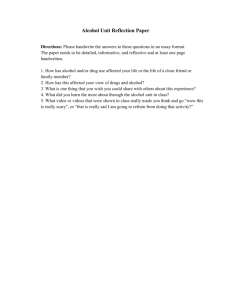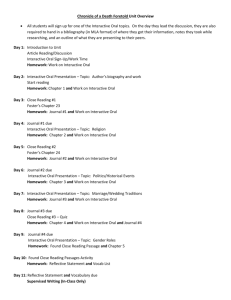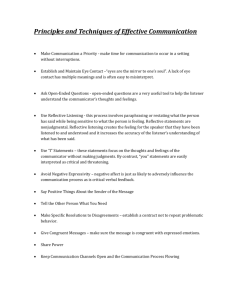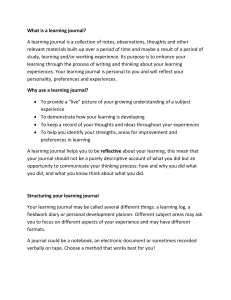personal reflective presentation
advertisement
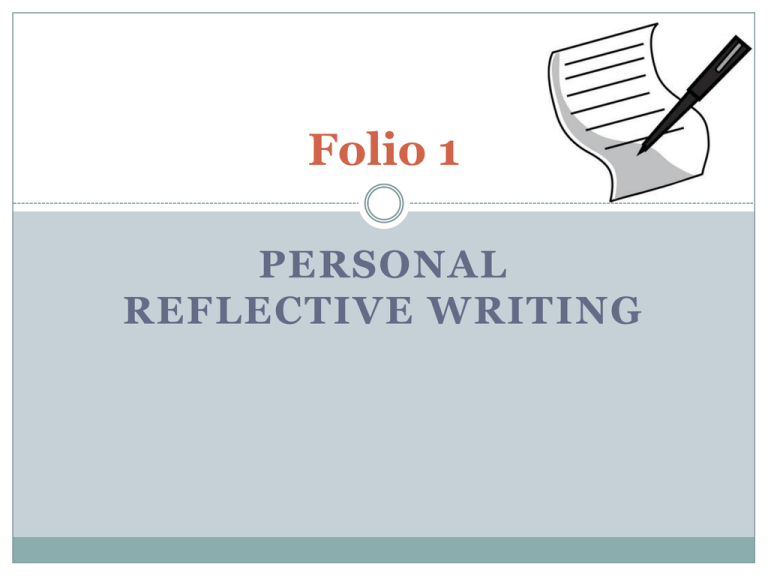
Folio 1 PERSONAL REFLECTIVE WRITING Learning Intentions and Success Criteria LI: 1. Gain an understanding of what reflective writing is and the expectations from the SQA. 2. Understand how effective reflective writing is created. SC: 1. Identify elements of effective reflective writing. 2. Develop skills and techniques of writing with emotion and using the senses. 3. Apply to your own writing. I can create a convincing impression of my personal experience and reflect on my response to the changing circumstances to engage my reader. ENG 4-30a Folio 1 Piece This is writing that CAN go home, but I need to see a plan first. Your goal for this period is to complete a plan for your first folio piece. This should have some detail so we can discuss where your writing is going. I need to see a plan by first thing on Thursday (8th) if not finished today. I will give you the 2 periods on Thursday to write it, but after that it becomes homework due on the Monday 26th October. Personal Reflective Essay Prompt Write a personal reflective essay using a concrete object as stimulus (photograph, memento, piece of jewellery, souvenir, keepsake, item of clothing). Describe the object then use it as a stimulus to discuss its deeper significance in your life. Warm-up: What is important to you? Take 5 minutes to think about items that are important to you or have significance in your life. 2. Create a list in your jotters of as many as you can. 3. Add to the list with your reasons why these are important. 1. Have at least one item and a reason that you can share back to the class. Keep these in mind during the rest of the activities. What is personal reflective writing? True personal experience Writer’s personality Feelings about what happened at the time and now Contemplation about events Does not just recall an event (e.g: my favourite holiday…) Still creatively written SQA: It will concern itself, usually, with a single idea, insight or experience and will include some reflection on knowledge, thoughts or feelings created by this. A Good Example? Read both of these extracts and decide which one you think is a better example of personal reflective writing. Write down at least 2 reasons why. I was planning on meeting my friends at seven o’clock after football to get some chips. I left the pitch at half six and walked to the bus stop. I had to wait twenty minutes because the bus was late. Eventually I made it to the chipper. I was drained by the time I had finished practice, but I set out to meet my friends at the agreed time. My stomach growled as I thought of warm greasy chips waiting for me. As luck would have it the bus was late – this of all days! Objects and Emotions Think back to your objects from the warm up. H0w do they make you feel? Write down at least one emotion for each object. Emotions Describing your emotions is crucial to personal reflective writing. ‘Mad’ won’t cut it. Don’t just tell emotions, show them. 2. ‘My hands 1. ‘I was really mad!’ curled into two tight fists. I could feel my face turn bright red as I glared at my brother. I could hold it in no longer as I threw the letter in his face and stormed up the stairs.’ What makes this second version more effective? Writing Emotion Practice How are these people feeling? 1. Tell the reader how you feel (in the first person). ‘I’m really….’ 2. Then show the reader how you feel using the example. Be descriptive. Describe your actions and emotions in 3-4 sentences. 1. 2. As you listen, decide what you think is effective about your classmates’ examples. Sentence Variety Using a variety of sentence types helps make your writing more interesting for the reader. 1. I’m running and my chest is tight and sore. I can hear my breath rasping and whistling in my lungs. As I run the branches whip against my face and brambles tear at my legs and arms. I can hear a voice screaming out loud. The screaming sound rips through the trees and I realise that it is my voice I am hearing. Use a variety of sentence lengths, from short and punchy, to more complex: 2. I’m running. My chest is tight and sore. Breath rasping and whistling in my lungs. Branches whip against my face. Brambles tear at my legs and arms. There is a voice screaming. Out loud. The sound ripping through the trees, screaming and screaming. It’s my voice. What makes the second example more interesting? What effect does it have on you as a reader? Personal Reflective Essay Prompt Write a personal reflective essay using a concrete object as stimulus (photograph, memento, piece of jewellery, souvenir, keepsake, item of clothing). Describe the object then use it as a stimulus to discuss its deeper significance in your life. Being Reflective Ask yourself: What did I learn from this? Why was this so important to me? Did I, perhaps change as a result of this? Did this affect how I felt about someone or something that was important to me? Was I pleased or disappointed with what happened? Has time made a difference to how I feel about my experiences? First Step Think back to the very first activity when you brainstormed objects that were significant to you. 1. Pick one of these or think of another that you could use to reflect on why it is important in your life. You might have learnt a lesson, something about yourself or about life. It might remind you of an important event that you could reflect on. Remember that you are not just telling a story. 2. Once you have decided you can begin planning your essay. Some Advice At some points you may have to describe the details (what, why, where, when, who). But, this should not be the focus of your essay. You must not just “tell a story”. You should only use this information as a basis to explore your thoughts, feelings and reactions! Personal Reflective Planning Success criteria What you might have learnt or how you have changed Content Layout Description of an object that means something to you: No more than 1000 words Descriptive and figurative language Introduction, development of ideas and resolution Makes use of the five senses Interesting title ‘Hooks’ the reader with an interesting introduction Why the object is meaningful: Style Event/person/experience it reminds Variety of sentence types to create you of the mood Show why this is significant Descriptive and figurative language Your thoughts and feelings: Shows rather than tells emotions Your thoughts and feelings at the time How your thoughts and feelings have changed now Plan Outline What object are you going to describe? 2. What elements of the description will you focus on? 3. Why is the object meaningful? 4. What will you reflect on? 1. Some Reflective Phrases Looking back On reflection With hindsight In retrospect I learned I realise I understand I should have I could have I wish I had Because of this I am Since this happened, I At the time When I think back on this Thinking about it now, I feel Now that I have been through this This experience has shaped me by I am glad this happened because Introductions Ways you can ‘hook’ your reader: 1. Ask a rhetorical question. Have you ever felt like you couldn’t make it through the day? 2. Make an outrageous statement that makes the reader intrigued. The wall came crashing down and my heart hammered in my chest. 3. Describe. It isn’t the crimson red bonnet or shiny new wheels, but the roar of the engine that is cemented in my mind.



